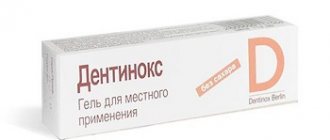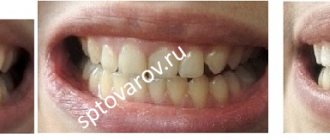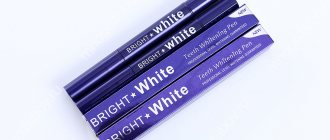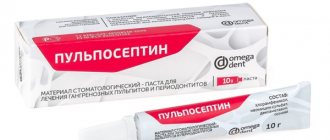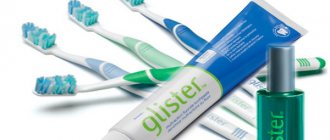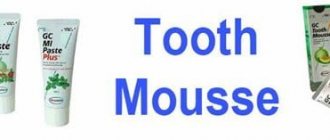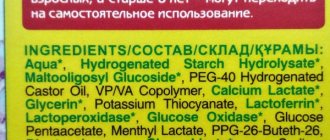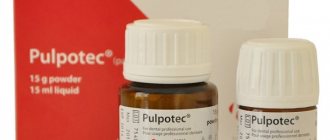To whiten tooth enamel, people usually go to a dental center. But professional whitening is not the only way to solve the problem. There are several effective home methods for caring for your teeth. The safest of them is procedures using tea tree oil. Unlike such popular remedies as soda, peroxide and lemon, essential oil acts gently without damaging the enamel. But it also needs to be used with caution. You will learn about the rules for using tea tree oil for dental treatment in this article.
Use in dentistry
The oil is actively used by dentists due to its medicinal properties:
- Strengthens gums and relieves inflammation. Due to its ability to quickly restore tissue and destroy pathogenic infections, it is recommended to rinse your mouth with oil for periodontal disease, gingivitis, and periodontitis. After 2 weeks of use, gum bleeding stops.
- Removing solid deposits. The oil softens not only soft plaque on teeth, but also hard plaque. With regular use, the stones begin to lag behind the enamel, that is, they break off.
- Elimination of unpleasant odor from the oral cavity. Plaque on teeth is a collection of bacteria. By getting into the membranes of pathogenic cells, tea tree neutralizes the infection. The plaque is removed, the smell disappears.
- Prevention of caries. The infection contaminates and destroys teeth, causing an inflammatory process - caries. By rinsing your mouth after eating, you can prevent the development of caries.
Thanks to its disinfectant, antibacterial, antimicrobial, healing properties, essential oil helps heal microcracks, injuries on the oral mucosa, strengthen gums and enamel.
General information
Melaleuca is an exclusively Australian plant. After water distillation, valuable essential oil is obtained from the juice of the leaves. It is a clear, light yellow liquid with an odor combining camphor and wood.
Containing a huge number of terpineols, it has powerful antimicrobial, anti-inflammatory, wound-healing, and soothing effects. Aborigines have used it since ancient times to cure serious illnesses, skin diseases, bites and burns.
Today its beneficial properties are used in medicine and cosmetology. It is an integral component of many cosmetics and medications.
The main use of the oil was as a teeth-lightening agent. Their tone changes when plaque is removed, which often causes the enamel to darken.
Effect on enamel
Teeth whitening is a gentle and strengthening procedure. Enamel, having a porous structure, suffers from plaque, which settles on the surface and instantly penetrates the pores. Bacteria and viruses immediately enter the tissue, causing an inflammatory process. Thanks to its astringent properties, teeth cleaning oil envelops the enamel, creating a protective film. Therefore, after using it, it is difficult for bacteria to penetrate into the pores. In addition, disinfectant properties help destroy pathogenic infections and prevent the development of inflammation.
After using tea tree oil, the enamel will not only become 2 shades lighter, but also strengthen and be protected from infection.
Tips for use
Changing the tone of teeth with tea tree oil is a safe and simple procedure.
But even when doing this, you must adhere to several recommendations:
- Strictly adhere to the recipe: observe the dosage of all components. Do not use oil more often or for longer than indicated in the recipe.
- Use only natural (without additives) oil. Its cost will be slightly higher, but when compared with other whitening means, it will remain low.
- As a preventative measure, bleaching is performed twice every 10 days. If an additional medicinal purpose is pursued, then the oil can be used daily for a month.
- During the entire course of using the product, you should not drink drinks containing dyes. The following are prohibited: strong tea, cocoa, chocolate, coffee, wine, juices.
- It is also necessary to exclude dishes that contain foods with coloring substances, for example, carrots, beets.
- The result of lightening will be negatively affected by the consumption of cold (hot) foods during this period.
- At the end of each procedure, you should rinse your mouth with water at room temperature. This action helps relieve numbness and remove any remaining product.
- During the entire course, it is important to ensure the supply of vitamins and microelements to the body, for example, through the presence of fruits and vegetables in the diet.
- It is not recommended to eat within an hour after completion of the procedure.
- For smokers: limit the number of cigarettes you smoke or quit them completely.
- After the first use of the oil, numbness of the lips, tongue, or an unpleasant taste may occur (these reactions are considered normal).
Tea tree oil is suitable for most people and will help lighten enamel if you follow these guidelines.
Selection rules
Unfortunately, not all oil manufacturers are decent. Some sell low-quality goods for selfish reasons. That's why there are negative reviews from people. They write that the tea tree oil bleaching method did not help. You need to know how to choose the right product, which companies are reputable manufacturers. Here's what you need to pay attention to when purchasing.
Name
The label should not contain phrases such as aromatic, perfumery product, identical to natural, a mixture of therapeutic, aromatherapy class. There is no therapeutic effect in such compositions. The oil content in the products is minimal. Such grouping by class simply does not exist. The inscription on the bottle label must contain the phrase 100% natural essential oil. If it is not available, you should not purchase the product.
Capacity
Essential oils cannot be stored for long in clear or plastic bottles. Real oil is stored only in dark glass bottles. This protects the product from ultraviolet rays, which destroy its structure. In addition, plastic has the ability to enter into a chemical reaction with oil and change its properties, which is also unacceptable.
Bottle volume
The container with real essential oil has a volume of no more than 10 ml. If you are offered to purchase a product in a 30 ml bottle for 100 rubles, you should know that it is a fake.
Certificate
Be sure to ask for a quality certificate when purchasing oil. It shouldn't be a copy. This is a document with original, “wet” seals.
Chromatogram
Serious and expensive analysis of the product, allowing you to accurately determine its composition. Probably, the chromatogram can be called the only category that gives a comprehensive answer about the quality of the product.
The absence of a chromatogram on the packaging is a sign of a synthetic counterfeit, an inexpensive analogue.
Prices
Essential oil, like any natural component, cannot be cheap. To obtain a small bottle, a large amount of raw material must be processed.
Manufacturers
For teeth whitening, give preference to the following companies:
- Aromatics.
- Natural oils.
- Bioderma.
- Delarom.
- Estée Lauder.
- Nuxe.
- L'Occitane.
Products from these manufacturers comply with European quality standards. They can be used not only for local processing, but also for internal use.
You can determine the authenticity of a product using a simple test. Drop the mixture from the bottle onto the paper. Since the oil is transparent, it should not stain the paper. But if after 15 minutes. there is not a trace left of the drop, which means you are being offered to buy a fake consisting of alcohol and volatile solvents. This will not only not bring healing and whitening effects, but will also harm your health.
Healing properties of tea tree
Tea tree oil is a medicinal substance that is produced from the Melaleuca Alternifolia plant, native to Australia. This natural drug has proven itself not only in folk medicine, but also in official medicine. Due to its healing properties, the product is often used in dentistry. It successfully fights pathogenic microbes living in the oral cavity, stops inflammatory processes, and soothes irritated mucous membranes. You can purchase this drug at almost any pharmacy. Many people suffering from various skin or fungal infections, ringworm, know about the antifungal and antiviral properties of the oil, so they use it to solve their health problems. The product is also suitable for treating dandruff and scalp care. Dentists value melaleuca oil for its healing properties, which is why they recommend it to their patients.
Attention! Using oil to remove yellow stains from tooth enamel is a gentle and gentle whitening method. The product does not contain abrasives or aggressive components that can damage the dental coating, so it can be used without fear. The active components of the oil soften dental plaque, returning the enamel to its natural color. Tea tree has antimicrobial, anti-inflammatory, regenerative, and soothing properties. The beneficial substances in its composition have a detrimental effect on fungi and microbes, soothe irritation, relieve inflammation, and accelerate the healing process of wounds.
Melaleuca is a species of plant from which “tea tree oil” is obtained, which has excellent anti-inflammatory and bactericidal properties. Research has shown that the leaves of this plant contain caffeine, tannin, and many vitamins, much more than lemon.
Since the drug is rich in useful substances, it is used not only to return teeth to their natural color, but also to treat and prevent certain dental diseases. What problems does this remedy help eliminate?
- Inflammatory gum diseases. Tea tree has a beneficial effect on gums, soothing them and eliminating bleeding. In Australia, dentists often recommend this product to their patients as part of their mouthwash.
- Tartar. The active components of melaleuca oil dissolve soft and old, hardened plaque. By regularly using this remedy, you can gradually get rid of tartar.
- Bad breath. This problem causes a lot of inconvenience not only to the person himself, but also to the people with whom he communicates. The cause of the unpleasant odor is the waste products of pathogenic microorganisms that actively multiply in the mouth during various diseases. Thanks to its disinfecting properties, the oil perfectly refreshes and heals the oral cavity and helps destroy pathogenic bacteria.
- Caries. Cariogenic bacteria living in the human mouth destroy tooth enamel, causing the development of such a common disease as caries. Almost every person is susceptible to it to one degree or another.
Attention! To prevent the development of caries, you can supplement your hygiene procedures with the use of melaleuca oil. To increase the effectiveness of its effects, it can be used in combination with plants such as horsetail, neem, and burdock.They are rich in antimicrobial, wound-healing and other substances that restore the microflora of the oral cavity, favorably affecting dental and gingival tissue.
pros
The oil has the following benefits as a whitening agent:
- The effect on enamel is gentle. The composition does not contain abrasive particles that destroy and thin the enamel.
- The mucous membrane is not irritated. Oil, on the contrary, heals microcracks and promotes cell regeneration during gingivitis and stomatitis.
- Antiseptic effect. Destroys bacteria, viruses, microbes.
- A simple way to whiten. Teeth lightening with tea tree can be easily done at home.
- Price. The cost of oil is several times lower than the price of professional whitening in a dental office.
- An exceptionally natural product. Does not contain chemically aggressive components.
But only real oil has such advantages; this does not apply to fakes.
Advantages
Despite the fact that it is possible to lighten enamel faster and more effectively by other means, oil has a number of advantages:
- natural lightening composition;
- does not injure and has a gentle effect on soft tissues and enamel due to the absence of mechanical influence on them;
- can be used even for stomatitis, periodontitis, gingivitis;
- does not cause irritation to the mucous membrane, but promotes its nutrition and healing in case of existing diseases;
- availability of lightening at home with minimal investment of time and money;
- ease of implementation;
- no side effects.
All of the listed advantages of the product make it one of the most common and popular.
Minuses
No matter how many positive aspects there are to whitening tooth enamel with oil, there is still a fly in the ointment:
- It will not be possible to achieve snow-whiteness. Using this method of whitening, you can return only the natural shade of the enamel. For a Hollywood smile, you will have to use professional lightening using special preparations.
- Eating products containing dyes and smoking will cause yellowing of the enamel.
- The first three minutes after the manipulations, the tongue goes numb, and taste perception changes.
- Not everyone likes a specific scent.
Another disadvantage is that if the bleaching agent gets into the stomach, nausea may occur.
Properties
Photo: tea tree oil
This plant, also called melaleuca, is native to the Australian continent. The local population - the aborigines - uses an extract from its leaves not only to treat fresh wounds, but also to treat sore throats and most colds.
Using water distillation of the leaves of this plant, an oil is obtained, which has enormous potential in the field of cosmetology and medicine.
. It looks like a pale yellow transparent liquid.
The smell has notes of wood and camphor. This substance contains more than a hundred terpineols, which have an antimicrobial effect.
This is why tea tree essential oil is an excellent antiseptic.
, that is, a disinfectant. It is included in a large number of medical anti-inflammatory and antiviral drugs.
One of the ways to use this universal remedy is to care for the oral cavity in general and whiten tooth enamel in particular. The action is based on the fact that plaque is removed from the surface, which in most cases is the reason for its color changing to a darker one.
Is teeth whitening with hydrogen peroxide effective? Read the reviews.
This article contains information about lightening enamel using activated carbon.
Well, here: https://www.vash-dentist.ru/krasota-i-uxod/zubnyie-pastyi/reyting-samyih-kachestvennyih-otbelivayushhih.html - a rating of the best whitening toothpastes has been prepared.
Rinsing
One of the most common ways to prevent plaque from settling and give freshness to your breath.
Rinse your mouth after every meal. If this is not possible, rinse your mouth at least 2 times a day.
The composition is very simple to prepare: add 5 drops of essential oil to 200 ml of warm boiled water. Stir with a teaspoon and rinse your mouth 3 times.
Ointment for external use Tea tree DN
Instructions for medical use of the drug
Description of pharmacological action
The tea tree is a low shrub or small tree belonging to the myrtle family (Myrtaceae). There are many varieties of tea tree, but only Melaleuca alternifolia has significant therapeutic properties. Tea tree essential oil is obtained from the leaves and branches of the tea tree by distillation. Tea tree oil contains alpha-pinene, alpha-terpinene, limonene, para-cymene, cineole-1,8, gamma-terpineol, terpinolene, terpen-4-ol, alpha-terpineol, etc. Most tea tree oils related to "therapeutic grades", contains about 3% cineole, and the terpene-4-ol content is 35% or more. Tea tree essential oil is a natural topical remedy with a wide range of effects. It has antiseptic, antifungal, antiviral, anti-inflammatory, regenerating and immunostimulating effects. The oil effectively inhibits the growth of bacteria such as staphylococci, streptococci, pneumococci, gonococci, E. coli and a number of others, as well as fungal flora. The disinfecting properties of the oil are used in medicine, hygiene, and cosmetology. The oil helps eliminate acne, warts, papillomas, dandruff, fungal skin infections, and is effective against insect bites, abrasions, and cuts. Strengthens hair follicles, which improves hair growth and structure. It has a calming aromatherapy effect, helps restore the body after stress, relieves anxiety, and promotes concentration. The aroma imparts reasonable determination, preventing panic and hysteria.
Indications for use
Tea tree oil can be used in dermatology both in its pure form and as an additive to other therapeutic agents. Widely used in cosmetology, being part of various skin care products. It is an aromatherapy agent. irritation, swelling, itching and redness of the skin (to cleanse the skin, relieve irritation); acne; pustular skin diseases (boils, etc.); wounds, cuts, abrasions; burns; insect bites; fungal diseases of the skin and nails; dandruff; eczema, dermatitis (except allergic), psoriasis; herpes (herpetic rashes on the skin and mucous membranes); warts, papillomas; sprains, dislocations; ARVI, flu, sore throat (rubbing, rinsing); gingivitis, stomatitis, periodontal disease, caries prevention (rinsing, lubricating); bronchitis (inhalation, rubbing); otitis (instillation into the ear); colpitis, vaginitis, prevention of viral, bacterial or fungal infections of the vagina (douching); hemorrhoids (suppositories, enemas); in aromatherapy (baths, inhalations, rinses, aroma lamp, aroma medallion, compresses, massage).
Release form
oil for external use; dark glass dropper bottle 20 ml cardboard pack 1; oil for external use; dark glass dropper bottle 30 ml cardboard pack 1; oil for external use; dark glass bottle (bottle) 20 ml cardboard pack 1; oil for external use; dark glass bottle (bottle) 30 ml cardboard pack 1;
Pharmacodynamics
Natural tea tree oil is a complex of extremely complex chemical composition, containing at least 48 organic components. Among them: terpenes, pinenes, cymones, terpineols, nineols, sesquiterpines, sesquiterpine alcohols. Tea tree oil also contains 4 components that are unlikely to be found anywhere else in nature: viridiflorene (up to 1%), B-terpineol (0.24%), L-terpineol (traces) and alligexanoate (traces). Tea tree oil is classified by the amount of cypeol (eucalyptol) and terpinen-4-ol it contains. Cineole has valuable medicinal qualities, especially for diseases of the respiratory tract, but it irritates the mucous membranes and skin. This means that tea tree oil, which contains large amounts of cineole, is not advisable for treating wounds, skin rashes, etc. According to the Australian Standard, Melaleuca alternifolia tea tree oil must contain terpinen-4-ol (not less than 30%) and cineole (not more than 15%). The highest quality tea tree oil should contain at least 35-28% terpinen-4-ol and only 5% cineole. Fake oil can be distinguished by its light sweetish aroma with a sharp camphor undertone. Currently, the content of individual components in tea tree oil is measured using a gas chromatograph. The medicinal effectiveness of tea tree oil against Candida fungi decreases if the content of alpha-terpinene, gamma-terpinene, terpinolene, terpinen-4-ol is reduced in it, and the content of cineole, limonene, and alpha-terpineol is increased. Independent microbiological studies have confirmed the effectiveness of tea tree oil against the following microorganisms: gram-positive bacteria: Staphylococcus aureus, Staphylococcus erider-midis, Staphylococcus pneumoniae, Staphyiococcus faecalis, Staphylococcus pyrogenes, Staphylococcus agalactiae, Propionibacterium acnes, Beta haemolytic steptococcus; gram-negative bacteria: Escherichia coli, Klebsiella pheuraoniac, Citrobacter spp., Shigella sonnei, Proteus mirabolis, Legioneila spp., Pseudomonas aeriginosa; mushrooms: Trichophyton mentagrophytes, Trichophyton rubrum, Aspergillus niger, Aspergillus flavus, Candida albicans, Microsporuv canis, Microsporum gypseum, Thermoactionomycetes vulgaris. In addition to its ability to suppress infections, tea tree oil has the property of stimulating the immune system, increasing the body's own defenses. The healing properties of tea tree oil are as follows: antiseptic, bactericidal, antifungal, antiviral and immunostimulating.
Contraindications for use
Individual intolerance to tea tree oil. When applied to the skin, a burning sensation and slight redness occur for 2-3 minutes. To check if you are allergic to this scent, put a drop of oil on a handkerchief and hold the handkerchief to your nose throughout the day. It is advisable to carry out the test within 2-3 days.
Side effects
Possible skin reactions: short-term burning, redness.
Directions for use and doses
Most common uses: Head: Cleansing hair and hair follicles: Add 5-10 drops of tea tree oil to a single serving of your shampoo and conditioner and use as needed until healing. Dandruff: proceed as in the previous case. Leave the shampoo for a few minutes and rinse. Dry hair: massage shampoo and conditioner with TEA TREE OIL into hair, leave for 10 minutes, rinse. Repeat once or twice a week. Soak combs, brushes and linen with tea tree solution (3 drops of oil per glass of hot water). Ear pain: heat olive oil with tea tree oil in a 2:1 ratio, drop 1-2 drops into the ear. Repeat as necessary. Colds, runny nose, cough: add 10 drops of oil to the inhaler; for a runny nose, rub a few drops into the skin of the bridge of the nose and forehead. Sore throat, laryngitis: add 5 drops of oil to warm water and gargle 2-3 times a day. Ulcers in the nose: soak a cotton swab in a mixture of tea tree oil and olive oil in a ratio of 1:5, gently treat the affected area. Face: Stye: Place 2-3 drops of oil in a cup of hot water. Keep your face over the steam for 5 minutes. Acne (blackheads): Apply 2-3 drops of oil to the infected area twice a day. Add oil to your facial cleanser. After shaving: used as a powerful antiseptic in a mixture with any of the oils in a ratio of 1:4. Colds, herpes, cracked lips: Brew 3 drops of tea tree oil in a glass of water in boiling water. Treat colds and herpes carefully with cotton wool twice a day. Teeth: Gingivitis, bleeding gums: dissolve 3-5 drops of oil in a small glass of boiling water, rinse twice a day, use tea tree oil to rub into the gums. Tooth decay: Place 2 drops of oil on your toothbrush when brushing your teeth. Rinse your mouth 3 times a day with water and 5 drops of oil. Toothache: rinse your teeth with water and tea tree oil, apply a cotton ball with oil to the sore spot. Body: Burns: treat the burned area with ice water for 1-2 minutes, apply a few drops of oil to the burned surface, massage gently. Repeat twice a day. This treatment helps to avoid skin infection and maintain its integrity. Cuts and abrasions: Apply tea tree oil. Bronchitis: rub your chest with 5 drops of oil, place a warm towel on your chest (you can wrap a heating pad in it) for 1-2 hours. Insect bites: Rub tea tree oil into the affected area. If the bite area is large, mix 1 part tea tree oil with 5 parts another vegetable oil. Dermatitis: Massage a few drops of oil using 1 part tea tree oil to 10 parts other cosmetic oil. Eczema: Make sure your skin is dry and apply tea tree oil to the affected area. Shingles: Mix 1 part tea tree oil with 10 parts any oil. Warm the mixture and apply to the painful area two or three times a day until the pain subsides. Add 10 drops of oil to a hot bath for heat therapy. Rheumatism: mix any heated oil in equal parts with tea tree oil and rub into the painful area until completely absorbed. Trophic ulcers: apply directly to ulcers 2-3 times a day. Warts: Gradually apply 3-5 drops of tea tree oil to the steamed wart until it is completely absorbed. Use until the warts fall off. This may take several weeks. Legs and Feet: Sports Injuries and Sprains: Massage pure tea tree oil into your feet. Use a daily anti-stress moisturizer for your legs and feet with tea tree oil. Calluses and blisters: Apply tea tree oil to the affected areas. It is also useful to add 5 drops of oil to a foot bath. Personal hygiene: Vaginal cleansing: dissolve 8-10 drops of tea tree oil with 0.5 liters of boiling water and use the cooled mixture for douching. Shaving in the bikini area: after shaving, apply tea tree oil mixed with any of the oils in a ratio of 1 to 4. Repeat 2 times a day. Redness and swelling will disappear. Skin cleansing: Tea tree oil is known to penetrate into the very deep layers of the skin. Add 1-2 drops of this oil to a single serving of your cream or lotion to help moisturize and soften skin. Household use: A large number of different viruses and microbes usually accumulate in rooms; synthetic items, carpets, cleaning solutions and paints can cause allergic reactions. Tea tree oil is a powerful antiseptic. Thus, cleansing, washing, and bathing with this oil is a safe, natural way to cleanse your home environment. Air humidification: add 10 drops of oil to the device to humidify the air, to clean the air and eliminate unpleasant odors. Bath: add 10 drops of oil to a bath of warm water. Take no more than 20 minutes. You will feel a pleasant softening of the skin. Bedsores: Applying a small amount of oil can help treat bedsores. Use a mixture of tea tree oil with olive or other oils in a ratio of 1 to 5. Baby care: Use a very small amount of tea tree oil mixed with other oils in a ratio of 1 to 10 on children's skin, as children's skin is very delicate and sensitive. . Washing diapers: add 20 drops of pure oil to 4 liters of hot water. Move and soak diapers overnight to disinfect. Crusts on the head: rub a mixture of oil with another oil in a ratio of 1 to 10 into the scalp, leave for 5 minutes, rinse. Use baby shampoo. Ear infection: drip 1-2 drops of a warmed mixture of other oils with tea tree oil in a ratio of 1 to 10. Cough: add 10 drops of pure tea tree oil to the inhaler. Place a drop of oil on your pillow. Aromatherapy: Massage: Mix a few drops of tea tree oil with lotion. This massage can relieve muscle pain and makes the skin soft and fresh. Humidifier: Add a few drops of oil to a mist and humidifier and place it in the room where the sick person is. This will help freshen and deodorize the air. This air is pleasant and useful for breathing.
Interactions with other drugs
The optimal result is achieved by combining tea tree essential oil as a medicine with other therapeutic methods. Tea tree essential oil can be used either alone or in combination with other essential oils. Can be added to creams and shampoos. When treating mucous membranes, dilute with vegetable, peach or sea buckthorn oils.
Precautions for use
Avoid contact with eyes, store in a cool place, do not store in plastic containers, keep out of the reach of children.
Special instructions for use
In case of illness, you can use essential oil yourself, but if after three days there is no visible improvement, you should consult a doctor or a specialist in essential oil treatment. Preliminary consultation with specialists is also necessary in cases where the essential oil must be applied directly to the skin. Not recommended for use on sensitive skin. If a burning sensation occurs, immediately rinse the area with water and consult a doctor. Women during pregnancy should always consult a doctor before using tea tree essential oil. Essential oils are powerful products. Strictly follow the precautions: do not use in pure form, do not apply internally, store in a cool place, keep away from children, avoid getting essential oil into the eyes. In case of contact with eyes, rinse thoroughly with cold water; if the burning sensation persists, consult a doctor. When taken orally, tea tree oil may be considered toxic, however, there are documented cases where researchers took fairly large doses (up to 120 drops per day) orally for 3 months to treat systemic infections. Such treatment should be carried out exclusively under the supervision of a physician who specializes in the ingestion of essential oils. Tea tree essential oil is a highly volatile substance and, like all similar substances, is flammable. Do not use essential oil near an open flame or place it in the sun.
Storage conditions
In a place protected from light, at a temperature not exceeding 25 °C.
Best before date
60 months
Classical technique
To remove pigmentation from enamel and lighten teeth, you should use the following cleaning technique:
- Brush your teeth with a brush and toothpaste.
- Rinse your mouth.
- Place three drops of oil on a cotton pad and wipe your teeth thoroughly.
- Rinse your mouth with water.
You can also use the following recipe for whitening: mix 3 drops of tea tree oil and 1 tsp. lemon juice. These components have the ability to enhance each other's effectiveness.
Pros and cons of the method
For your information! Since natural melaleuca essential oil has antifungal, antibacterial and wound-healing effects, the main advantages of home whitening with its help include:
- safety of the procedure itself;
- its beneficial effect on the gums;
- simplicity of such bleaching.
However, along with the advantages, home whitening with this drug also has its disadvantages.
And the most noticeable disadvantage is the taste and aroma of the product .
After all, quite a large number of people refuse such bleaching only because they cannot calmly tolerate the smell of such a product.
The second no less significant disadvantage is the reaction of the human body tea tree oil is ingested Most often, this is vomiting and diarrhea .
At the same time, it is quite easy to prevent such consequences: it is enough to clearly control the bleaching process and prevent ingestion of the product.
Improving toothpaste
You can not only rinse your mouth with oil, but also brush your teeth in combination with toothpaste. This will help improve its quality and disinfect the oral cavity. Still, not all cleaning products have antiseptic properties (unlike tea tree).
Cleaning technique:
- After applying the paste to the brush, add 3 drops of oil;
- brush your teeth first in the lower jaw, then in the upper jaw;
- the nature of the movements is sweeping, circular;
- don’t forget to clean your tongue and inner cheeks;
- rinse your mouth with mineral or plain water.
To improve the effect, you can dip the brush in baking soda, then apply the paste and oil. Baking soda also has a whitening effect. But you can use it no more than once a week. Soda contains particles that, if used regularly, injure and destroy enamel.
Popular recipes
Some ways to help whiten enamel using tea tree oil are given below. They all have their own characteristics and advantages.
Cleaning
This method is the easiest to use at home, as it does not take time or effort to prepare. For convenience (and so as not to forget!) you just need to keep a bottle of oil in the bathroom next to your usual hygiene products.
- First of all, you should carry out the usual procedure for brushing your teeth, using the toothpaste that you are used to.
- After this, be sure to rinse your mouth well to get rid of any remaining product. It is better if the rinsing water is warm enough - about 20°C.
- Then, you need to take a clean brush and apply a few drops of oil to it. You can take your own brush after washing it first, or you can purchase an additional one, intended only for this procedure.
- Now they clean again, without being too zealous, so as not to expose the enamel to the danger of abrasion.
- The last stage is rinsing.
When using this oil in the first procedures, you may experience unpleasant sensations associated with an unusual taste and numbness in some areas of the mucous membrane.
. However, this phenomenon is temporary, it passes quickly, and after rinsing there is no foreign taste left in the mouth.
This method is not recommended to be used constantly and regularly. It is enough to do this twice a week.
Rinse
Another method of whitening, in which you will not need to brush, but rinse your mouth with this product. It also shows pretty good results.
However, the application of the procedures extends over a longer period and requires patience, since the effect is not achieved immediately.
Add a few drops (2-3) of tea tree oil to half a glass of warm and clean water. Rinse with the resulting mixture before regular teeth brushing.
Moreover, after them you should not rinse your mouth with clean water. After a few minutes, you can brush your teeth with your brush and toothpaste.
The effect of removing plaque and whitening is the gentle effect of the substances contained in the oil on the bacteria that make up the deposits. They soften, after which a regular brush becomes much more effective.
When using such rinses, practically no unpleasant phenomena occur, so this method is recommended for people with increased enamel sensitivity.
Oil mixture
The third recipe also involves the use of an additional ingredient - lemon oil.
. This procedure is practically identical to that described in the first recipe.
That is, first brush your teeth with regular toothpaste, rinse thoroughly, and only then apply additional oils.
The difference is that one lemon oil is added to two or three drops of the main product.
. This method is considered the most effective and efficient, since both products are excellent antiseptics and quite quickly help get rid of dark plaque.
As in the first case, you should not often carry out such non-standard cleanings. Just twice a week is enough to get a lighter shade of enamel after a while.
Usually, if a person does not forget to carry out all standard hygiene procedures and combines them with whitening, the course lasts about a month. Then the lightening of the enamel will be clearly visible.
Deadlines
We have already talked a little about the timing of using these techniques, but there are some variations. If you carry out procedures not twice a week, but every day, this will help speed up the desired effect.
In this case, you should not continue the course for a whole month; only one, perhaps a week and a half, is enough to get a lighter shade of your teeth.
The effect of the oil is not permanent
, therefore, after some time (from a month to six months or even more), the whitening course will have to be repeated, using the same technique as the first time.
However, this is not an isolated case - almost all methods, even medical ones, require repeated treatment by the patient. This is due to smoking and consumption of various coloring substances contained in coffee, tea, some other drinks and food, as well as lack of hygiene.
Folk recipes
When using any recipe, avoid ingesting cleaning compounds.
Be sure to rinse your mouth thoroughly with water after the procedure.
Aloe and tea tree oil
For sensitive enamel, a mixture of 3 drops of oil and 1 tsp will be useful. aloe juice Rub the mixture into the surface of your teeth with your finger or apply the mixture onto a cotton pad.
Tea tree oil and mineral water
A solution consisting of 1 drop of oil and 1 tsp is good for lightening teeth. mineral water. Rub it into the enamel for 2-3 minutes after meals at least 2 times a day.
Lemon+soda+tea oil
Mix 1 tsp. soda, 0.5 tsp. freshly squeezed lemon juice to a paste consistency. Add 2 drops of oil and mix again until smooth. Dip your toothbrush into the mixture and gently massage your teeth. Leave the composition on the enamel for 1 minute. Do not touch your gums to avoid injuring them.
Use this cleaning method no more than once a week.
Treatment of bleeding
Tea tree has been successfully used to treat gum disease and quickly helps eliminate bleeding. If you encounter such a problem, you will need one of the following methods.
Applications
A small cotton swab is soaked in oil and applied to the gum for 10-15 minutes. Then perform a light massage of the gums. After the procedure, do not forget to rinse your mouth thoroughly with clean water. If your teeth are sensitive, this method will help you avoid discomfort. Ether (3 drops) is mixed with a teaspoon of aloe. The resulting mixture is rubbed into the gums with light movements.
Therapeutic rinses
Rinsing with tea tree oil daily will help with bleeding gums.
To combat gingivitis and bleeding, dentists recommend rinsing your mouth daily with an essential oil-based composition. The solution is prepared as follows: add 8-9 drops of oil to a glass of hot water.
Good to know! Symptoms of bleeding also disappear when brushing your teeth with a paste containing tea tree ether. Therefore, to treat gums, you can use the same method as for whitening enamel.
Breath freshening
Bad breath is a problem familiar to many. The oil neutralizes odor and makes your breath fresh. Any of the methods described above will work for this.
The cause of bad breath is dental plaque, which contains a huge number of pathogenic microbes. They produce bad-smelling substances. You can get rid of the smell in a very simple way - after eating, rinse your mouth with a weak solution of essential oil.
Contraindications
Avoid the idea of teeth whitening in the following cases:
- Fragile, thinned enamel. This may be evidenced by constantly developing secondary caries.
- Pregnancy. During the procedure, it is rarely possible to avoid swallowing even a small amount of cleanser. It is harmful. To prevent negative effects on the fetus, you should avoid the procedure during pregnancy. In addition, even a slight impact on the enamel can cause its destruction. During pregnancy, almost all calcium from the mother's body is sent to the development of the fetus.
- Lactation period. If the essential oil gets into the stomach and is then absorbed into the systemic bloodstream and then into the milk, this can trigger the development of allergies in the child. Tea tree oil is a strong allergen.
- Age up to 18 years. Until this time, the formation of enamel is still underway. Until the age of 18, it is in the stage of mineralization. Lightening teeth using this method can cause tooth decay.
- Allergic reaction. A test should be carried out before using the oil. Apply a drop of the substance to the back of your forearm. If after 24 hours no redness or burning sensation appears, then you can use the method.
Ideal option: Consult your doctor or dentist about teeth whitening with oil.
Secret No. 1: find out if you have any contraindications
The main secret of the success of traditional medicine lies in the slogan “do not harm yourself.” After all, various folk recipes can benefit one person and ruin the health of another. This conclusion is also true for tea tree oil. To prevent the consequences of using the product from becoming sad for your body, be sure to check the list of contraindications for its use:
- tendency to allergies and intolerance to the components of the drug: especially if you have already had a reaction to allspice, guava, eucalyptus, cloves, thyme, celery,
- inflammatory processes in the acute phase on the mucous membrane,
- bronchial asthma,
- cannot be used by pregnant and lactating women,
- Oil should not be given to children under 10 years of age,
- It is unacceptable to use the oil internally: it is for external use only,
- Do not use expired composition that has been stored for a long time in a place unprotected from light or in a plastic container.
It must be said that there are about two hundred species of such trees in the world, but medicinal oil is obtained only from a tree of one species, scientifically called Melaleuca alternifolia and growing in Australia. The oil is obtained from its green leaves. And the healing properties of the product were known back in the time of Cook, who discovered a new continent: the natives of the island themselves used crushed leaves of the tree to treat wounds and to repel insects. And Captain Cook's sailors fell in love with the woody aroma of the leaves and brewed a tea drink from them, which was very invigorating.
Recommendations
Observe the following rules when carrying out clarification:
- Do not exceed the recommended dosage of oil, otherwise you will experience numbness in your mouth.
- Rinse your mouth thoroughly after whitening yourself.
- If you are not satisfied with the taste of tea tree, after the procedure, rinse your mouth by mixing a glass of water and 1 tsp. soda or lemon juice.
- After 1 month of teeth whitening, take a three-week break.
- Use high quality natural oil.
- After treating the enamel, refrain from eating for an hour.
During and after the lightening procedure, you should minimize the consumption of strong black tea, coffee, cocoa, chocolate, juices, wine, colored sauces, carrots and beets.
Reviews from "patients"
Most people want to make their teeth whiter in order to make their smile attractive and stop feeling self-conscious about it due to an unpleasant shade of enamel. You can share your reviews about the proposed home whitening product with others in the comments to this article.
And in conclusion, a short video with Elena Malysheva about teeth whitening:
If you find an error, please select a piece of text and press Ctrl+Enter.
Tags tea tree oil teeth whitening
Did you like the article? stay tuned
Previous article
Teeth whitening with hydrogen peroxide: techniques and reviews
Next article
What to do if your gums hurt after tooth extraction surgery?
Reviews
Anna
“I really liked the lightening technique. Pleasant aroma of oil plus good results. My teeth became really lighter, the yellowness was gone. Moreover, I saw this in the photos that I took before and after the procedure.”
Elena
“I tried whitening my teeth with hydrogen peroxide before. Cool tool. But since the dentist recommended that I alternate between different techniques, I decided to try brushing my teeth with tea tree oil. My gums were also bleeding a little. Within two weeks, the bleeding disappeared, and the teeth became shiny.”
Oksana
“It was enough for me to carry out this procedure three times a week. I saw the result in about a month. First, I brushed my teeth with paste, rinsed the brush, and then applied 2 drops of oil to it and brushed my teeth again. Everything else, as usual, according to the standard: rinse, spit. White teeth and a pleasant feeling of freshness in the mouth are the result of efforts.”
How to choose a good essential oil?
Today in Russia there is not a single government structure whose responsibilities include monitoring the process of production of essential oils.
As a result, in the store you can find not only natural products, but also synthetic ones.
You should know! Determine that tea tree oil is natural based on the following principles:
- The bottle should be made of dark glass.
- Its label must indicate the Latin name of the plant.
- The plug must be equipped with a first opening ring.
- If you drop a drop of essential oil onto paper, then after about an hour the obviously greasy mark should disappear.
Important: only a chromatogram can indicate with 100% accuracy the natural or artificial origin of an essential oil.
A little history from Doctor Zubastic
Tea tree has nothing in common with ordinary tea. This name was given to it by the famous traveler James Cook. While traveling in Australia, Cook was bitten by a tick. In one of the settlements, the aborigines made a lotion from a decoction of the leaves of an unknown tree. The same decoction was given to the traveler instead of tea.
The natives called the drink miraculous and said that they treat almost all diseases with the leaves of this tree, drinking it instead of tea throughout the day. So Cook called Melaleuca (its real name) a tea tree. Subsequently, studies were carried out and antiseptic and antimicrobial properties were identified.
Tags: aloe, lemon, folk remedies, whitening, soda, tea tree
About the author: Dr. Zubastik
Typically, a toothache begins to subside on the way to the clinic and finally goes away after 10 minutes of sitting in line to see the dentist.
- Related Posts
- Teeth whitening with coconut oil: recipe with photos (+ reviews)
- How to rinse your gums at home if they are inflamed?
- Secrets of home teeth whitening using lemon
« Previous entry
Comments
I never would have thought that you could use tea tree oil to whiten your teeth. The oil should be 100%, is it ok from a regular pharmacy? Or do we not sell these and need to order them somewhere?
Veronica (01/29/2019 at 04:01 pm) Reply to comment
This is the first time I’ve come across that tea tree oil is used to whiten teeth. I’ve read so many things about what homemade, handy remedies are used to whiten teeth. And my dentist forbids me everything. I’m tired of asking him, but this is possible, but this doesn’t allow anything. Does the oil have any contraindications? Doesn't it damage the enamel?
Tonya (01/29/2019 at 08:17 pm) Reply to comment
- Teeth whitening, even at home, should always be done, firstly, wisely, and secondly, always after consultation with a doctor, so as not to harm the enamel.
Editorial staff of the portal UltraSmile.ru (02/01/2019 at 07:16) Reply to comment
Can tea tree oils be used to whiten teeth if you have a couple of dentures? And where you can buy this product is very tempting and simple.
Ramilya (02/03/2019 at 22:37) Reply to comment
My enamel is very fragile, can you tell me if I can use tea tree oil?
Alina (02/04/2019 at 12:39 pm) Reply to comment
- Dear Alina, we do not advise you to do this. Unfortunately, people with very fragile enamel are simply obliged to consult a dentist when using such whitening compounds for the sake of their health. And the doctor can recommend you means of strengthening your teeth (for example, fluoridation or remineralization), prescribe special pastes and vitamin complexes. Only after the enamel has been strengthened will it be possible to return to the issue of safe whitening.
Editorial staff of the portal UltraSmile.ru (02/07/2019 at 08:56) Reply to comment
I have been looking for a safe remedy for yellow teeth for a long time. And there is one problem - tartar. Tell me, is it permissible to use tea tree oil for teeth whitening in this case?
Irina (02/04/2019 at 15:46) Reply to comment
I’ve been using tea tree oil for teeth whitening for about 5 years now, but I’ve always been concerned, because no matter how much you rinse your mouth, the oil can still get into your stomach - is that okay?
Sveta (02/04/2019 at 18:05) Reply to comment
Tea tree oils for teeth whitening are suitable for everyone as far as I know. Is there a difference between expensive and cheap oils? In stores, prices fluctuate greatly, but everywhere it’s just butter.
Alena (02/04/2019 at 18:13) Reply to comment
Can tea tree oils be used for teeth whitening at any age? My daughter is 15 years old, her teeth are already turning yellow, and since she is young, I’m afraid to take her straight to some serious teeth whitening procedures.
Albina (02/04/2019 at 18:21) Reply to comment
I use tea tree oil for teeth whitening periodically, but I always bought expensive, good oil at the pharmacy. If you take something from a range of cheap ones, will there be any effect or result?
Sveta (02/12/2019 at 11:16 am) Reply to comment
Using tea tree oil to whiten teeth is a real discovery for me. I used baking soda in combination with peroxide - it removes plaque well, but with the top layer of enamel. I hope the oil gently removes plaque and does not damage your teeth. How can I determine at home if I am allergic to it?
Margot (02/12/2019 at 02:08 pm) Reply to comment
I started using tea tree oil for teeth whitening when I was still a student. I don’t know why no one told me about this method before, but it really works. Probably can't be used without a break? I sometimes use it for weeks.
Andrey (02.12.2019 at 14:16) Reply to comment
Write your comment Cancel reply
Contraindications and harm from using the product
As with any other type of healing, there are limitations when using aromatic oils:
- individual intolerance;
- allergic reactions;
- poor perception of smell and taste of products containing essential oils;
- use of the product undiluted;
- pregnancy and lactation, age up to 12 years (the possibility of using tea tree oil for teeth is considered on an individual basis);
- bronchial asthma (consultation with your doctor is required).
Side effects sometimes include thinning and damage to tooth enamel. This phenomenon is observed only when whitening procedures are carried out too often and for a long time. And when using the product undiluted, burns of the mucous membranes of the mouth are possible, so you need to make applications extremely carefully to prevent this.
There are few contraindications and unwanted side effects, so if you use the oil in the indicated doses, it will not cause harm.

